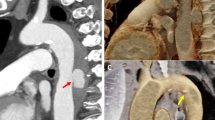Abstract
Acute aortic injuries are not common in the setting of severe blunt trauma, but lead to significant morbidity and mortality. High-quality MDCT with 2D MPRs and 3D rendering are essential to identify aortic trauma and distinguish anatomic variants and other forms of aortic pathology from an acute injury. Misinterpretation of mimics of acute aortic injury can lead to unnecessary arteriography and thoracic surgery. Since most traumatic injuries occur in the distal arch, radiologists must be cognizant of the range of appearances of variants related to the ductus diverticulum. Cinematic rendering (CR) is a new 3D post-processing tool that provides even greater anatomic detail than traditional volume rendering. In this case series, CR is used to impart to radiologists a better understanding of various anatomic configurations that can be seen with a ductus diverticulum.




Similar content being viewed by others
References
Schicho A, Lürken L, Meier R, Stroszczynski C, Schreyer A, Dendl LM, Schleder S (2017) Non-penetrating traumatic injuries of the aortic arch. Acta Radiol Jan 1:284185117713352. https://doi.org/10.1177/0284185117713352
Fox N, Schwartz D, Salazar JH, Haut ER, Dahm P, Black JH, Brackenridge SC, Como JJ, Hendershot K, King DR, Maung AA, Moorman ML, Nagy K, Petrey LB, Tesoriero R, Scalea TM, Fabian TC (2015) Evaluation and management of blunt traumatic aortic injury: a practice management guideline from the Eastern Association for the Surgery of Trauma. J Trauma Acute Care Surg 78(1):136–146. https://doi.org/10.1097/TA.0000000000000470
Alkadhi H, Wildermuth S, Desbiolles L, Schertler T, Crook D, Marincek B, Boehm T (2004) Vascular emergencies of the thorax after blunt and iatrogenic trauma: multi-detector row CT and three-dimensional imaging. Radiographics 24(5):1239–1255. https://doi.org/10.1148/rg.245035728
Ait Ali Yahia D, Bouvier A, Nedelcu C, Urdulashvili M, Thouveny F, Ridereau C, Tanguy JY, Picquet J, Aube C, Willoteaux S (2015) Imaging of thoracic aortic injury. Diagn Interv Imaging 96(1):79–88. https://doi.org/10.1016/j.diii.2014.02.003
Eid M, De Cecco CN, Nance JW, Jr., Caruso D, Albrecht MH, Spandorfer AJ, De Santis D, Varga-Szemes A, Schoepf UJ (2017) Cinematic rendering in CT: a novel, lifelike 3D visualization technique. AJR Am J Roentgenol 209 (2):370–379. doi:https://doi.org/10.2214/AJR.17.17850
Johnson PT, Schneider R, Lugo-Fagundo C, Johnson MB, Fishman EK (2017) MDCT angiography with 3D rendering: a novel cinematic rendering algorithm for enhanced anatomic detail. AJR Am J Roentgenol 209(2):309–312. https://doi.org/10.2214/AJR.17.17903
Batra P, Bigoni B, Manning J, Aberle DR, Brown K, Hart E, Goldin J (2000) Pitfalls in the diagnosis of thoracic aortic dissection at CT angiography. Radiographics 20(2):309–320. https://doi.org/10.1148/radiographics.20.2.g00mc04309
Rowe SP, Johnson PT, Fishman EK (2017) Initial experience with cinematic rendering for chest cardiovascular imaging. Br J Radiol Sep 22:20170558. https://doi.org/10.1259/bjr.20170558
Dappa E, Higashigaito K, Fornaro J, Leschka S, Wildermuth S, Alkadhi H (2016) Cinematic rendering—an alternative to volume rendering for 3D computed tomography imaging. Insights Imaging 7(6):849–856. https://doi.org/10.1007/s13244-016-0518-1
Morse SS, Glickman MG, Greenwood LH, Denny DF Jr, Strauss EB, Stavens BR, Yoselevitz M (1988) Traumatic aortic rupture: false positive aortographic diagnosis due to atypical ductus diverticulum. AJR Am J Roentgenol 150 (4):793–796, DOI: https://doi.org/10.2214/ajr.150.4.793
Steenburg SD, Ravenel JG (2008) Acute traumatic thoracic aortic injuries: experience with 64-MDCT. AJR Am J Roentgenol 191(5):1564–1569. https://doi.org/10.2214/AJR.07.3349
Author information
Authors and Affiliations
Corresponding author
Ethics declarations
Conflict of interest
Elliot K. Fishman receives grant funding from Siemens and GE Healthcare. He is a co-founder and stockholder of HipGraphics, Inc. Pamela T. Johnson and Steven P. Rowe have no conflict of interest.
Rights and permissions
About this article
Cite this article
Rowe, S.P., Johnson, P.T. & Fishman, E.K. MDCT of ductus diverticulum: 3D cinematic rendering to enhance understanding of anatomic configuration and avoid misinterpretation as traumatic aortic injury. Emerg Radiol 25, 209–213 (2018). https://doi.org/10.1007/s10140-018-1578-y
Received:
Accepted:
Published:
Issue Date:
DOI: https://doi.org/10.1007/s10140-018-1578-y




